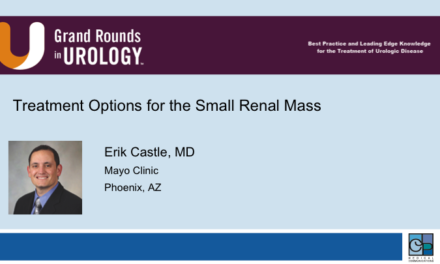
Systemic therapy for oligo-progressive, metastatic renal cell carcinoma (mRCC) treated with stereotactic radiosurgery (SBRT): to switch or not to switch?
Abstract
There are limited data regarding the role of changing systemic therapy upon receiving SBRT for oligo-progression (O-PD).
We reviewed our experience comparing switching vs. maintaining systemic therapy in mRCC patients receiving SBRT to brain or osseous metastases for O-PD. Patients who were off systemic therapy for more than 8 weeks before or after SBRT date were excluded.
The treatment response outside SBRT site was evaluated according to RECIST criteria for extra-osseous disease and incorporated clinical (symptoms) and radiographic criteria (new lesions in scans) for bone metastases. O-PD included patients who had all progressive lesions treated with SBRT and no other sites of PD outside SBRT site(s).
Based on the timing of systemic therapy switch after SBRT, two groups were identified: (STAY) patients remained on the same systemic treatment; (SWITCH) patients changed systemic therapy after the completion of SBRT. Systemic therapy change or not was made at the treating physician discretion. Treatment duration was defined as the time interval between SBRT date and last day of systemic therapy for the STAY group; for the SWITCH group, it was the time interval between C1D1 and last day of the first subsequent therapy after SBRT.
Among 308 mRCC patients who were treated with SBRT to brain or osseous metastases at CCF between 2005-2017, 103 clear-cell mRCC patients met inclusion criteria. Patients who had PD outside SBRT (n=33) or with no response information available (n=3) were excluded. Final analysis included 67 patients with median age 60 (range, 39-75), 78% male, 88% ECOG 0-1, with 55% IMDC-intermediate risk.
Thirty-five patients had SBRT to brain (frontal 51%, parietal 37%, cerebellum 35%; median number lesions=2) and 32 patients had SBRT to bone (spine 88%, median number lesions=1). Local control after SBRT was achieved in 85% of treated sites.
At the time of SBRT, most patients were being treated with sunitinib (40%), axitinib (24%) or everolimus (10%). Systemic treatment was first-line for 39% of patients, second-line for 31% and third-line or greater for 30%. Best RECIST response was CR in 3% and PR in 33%.
Patients included in the STAY (n=47) and SWITCH (n=20) groups had generally similar characteristics and were treated with a median number of 1 and 2 subsequent lines of treatment after SBRT, respectively. The median time on therapy for STAY and SWITCH groups was 5.2 months (95% CI 4.4-6.0) and 5.0 months (95% CI 4.1-5.9), respectively (p= 0.659). The median OS for the STAY group was 19.1 months (95% CI 7.1-31.4), compared with 27.1 months (95% CI 12.1-42.1) for the SWITCH group (p=0.575).
Our findings suggest that SBRT for patients with mRCC and O-PD in brain or bones is feasible and provides excellent local control. Maintaining patients on their current systemic therapy in the setting of O-PD does not compromise treatment durability, progression or survival.
Authors: Barata, Pedro | Kotesha, Rupesh | Angelov, Lilyana | Chao, Samuel | Mendiratta, Prateek | Elson, Paul | Koshkin, Vadim | Ornstein, Moshe | Gilligan, Timothy | Grivas, Petros | Wood, Laura | Rini, Brian | Garcia, Jorge
Journal: Kidney Cancer, vol. 2, no. s1, pp. I-S50, 2018



